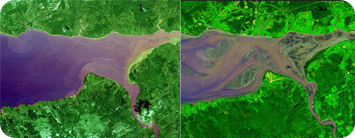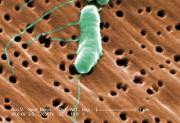Radio Program
Our regular Science and the SeaTM radio program presents marine science topics in an engaging two-minute story format. Our script writers gather ideas for the radio program from the University of Texas Marine Science Institute's researchers and from our very popular college class, Introduction to Oceanography, which we teach to hundreds of non-science majors at The University of Texas at Austin every year. Our radio programs are distributed at to commercial and public radio stations across the country.
Like the fire-breathing monster for which it’s named, a jagged tower of rock and metal named Godzilla rose high above the ocean floor -- more than 15 stories. A jet of scalding water blasted from its top. And not even decapitation could stop it: After its top two-thirds fell over, it kept on jetting black water, and quickly began rebuilding itself -- a process that continues today.

Like the fire-breathing monster for which it’s named, a jagged tower of rock and metal named Godzilla rose high above the ocean floor -- more than 15 stories. A jet of scalding water blasted from its top. And not even decapitation could stop it: After its top two-thirds fell over, it kept on jetting black water, and quickly began rebuilding itself -- a process that continues today.
{mosimage}
Call it “Oyster’s Revenge.” It’s a nasty little bacterium that can give you a nasty tummy-ache and other problems if you eat raw oysters or other undercooked shellfish. And it can even infect you if you wade through warm seawater -- usually in marshlands or other protected coastal environments.
Call it “Oyster’s Revenge.” It’s a nasty little bacterium that can give you a nasty tummy-ache and other problems if you eat raw oysters or other undercooked shellfish. And it can even infect you if you wade through warm seawater -- usually in marshlands or other protected coastal environments.
{mosimage}
In the movies, any big surge of water from the oceans -- the result of an underwater earthquake or a crashing asteroid -- is often called a tidal wave. But it’s another case of Hollywood not quite getting things right. A tidal wave is a predictable event. But a giant wave created in a violent event is known as a tsunami.

In the movies, any big surge of water from the oceans -- the result of an underwater earthquake or a crashing asteroid -- is often called a tidal wave. But it’s another case of Hollywood not quite getting things right. A tidal wave is a predictable event. But a giant wave created in a violent event is known as a tsunami.
{mosimage}
The bottom of the Gulf of Mexico leaks like a roof after a hailstorm. Oil and natural gas ooze up through cracks in the seafloor. But these cracks aren’t zones of death, as you might expect. Instead, they’re home to thriving colonies of tube worms, crabs, and other animals -- including tiny creatures known as “ice worms.”
The bottom of the Gulf of Mexico leaks like a roof after a hailstorm. Oil and natural gas ooze up through cracks in the seafloor. But these cracks aren’t zones of death, as you might expect. Instead, they’re home to thriving colonies of tube worms, crabs, and other animals -- including tiny creatures known as “ice worms.”
{mosimage}
As supplies of oil and natural gas continue to shrink, scientists are looking for new sources of energy to replace them. One place they’re looking is the bottom of the oceans. Huge amounts of natural gas -- mostly methane -- are “frozen” in layers known as gas hydrates.
As supplies of oil and natural gas continue to shrink, scientists are looking for new sources of energy to replace them. One place they’re looking is the bottom of the oceans. Huge amounts of natural gas -- mostly methane -- are “frozen” in layers known as gas hydrates.
{mosimage}



